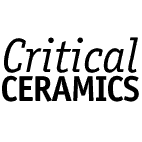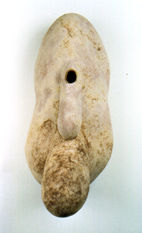

copyright © 2000 NCECA. Used by permission.






FORREST SNYDER
Mr. Scott Chamberlin’s twelve year retrospective, ‘Twelve Years: Drawing and Sculpture’, at The Museum of Contemporary Art Denver (2 March - 7 May 2000, 1275 19th Street, Denver CO 80202; 303-298-7554) was one of the major shows for this year’s National Conference on Education in the Ceramic Arts (NCECA). Mr. Chamberlin is a ceramic artist of national and international note, beginning his solo career at Dorothy Weiss Gallery (San Francisco CA) in 1987; Chamberlin has taught at the University of Colorado - Boulder since 1985.
Three types of work were presented in this exhibition: pastel and charcoal drawings, large floor standing ceramic sculptures, and wall hung ceramic sculptures. Although each displayed distinct character, all three were clearly from the same branch of an evolutionary tree. To varying degrees, form, color, and subject carried across all. The drawings and large free standing sculptures were displayed together and echoed one another in their organic topiary beginnings. The wall sculptures, isolated from the other works, were shown in two smaller galleries.
Mr. Chamberlin’s drawings were fresh and alive. They consisted of semi-abstract trees, bushes, and garden topiary. These drawings succeeded because of what they do not show for as much as they do. In each, the gardener skillfully leads the viewer around the bush or tree, promising a view more wonderful than the last. Smartly, the cropping of the topiary scenes leave room for one’s mind to wander the garden path. These colorful drawings continued growing, leaves blowing, in the viewer’s mind long after leaving the gallery.
One of the key aspects of gardens, in particular formal gardens, is that they provide the visitor with the means to travel to another time and place. Gardens are superb vehicles for journeying to imaginary lands. Thus, the skillful gardener, while following some rules and owing much to the gardens afore, grows the unexpected flower, trims the yew hedge into a new masterpiece. Moreover, these subjects provide a frame or focus to the space that is not filled. In other words, the garden is not just about disengaged individuals, but rather the relationships the plantings have with one another. Too, the finest garden works, not unlike superlative sculpture, allow for new discoveries on each return visit. In perception, neither are static, unchanging, or ever completely known.
In “Helix” (1989), Scott Chamberlin executed a loose interpretation of a topiary scene in three dimensions. As with many of the floor pieces, “Helix” consisted of three parts progressing in height and stature. The progression ran, perhaps too predictably, through most of the large floor works. They felt a bit formulaic; the lower vessel form moves the viewer along towards the middle form. The tallest third piece acting as a stop to the entire work. Chamberlin used several means to achieve the hierarchy: progression of form mass or height and dominant colors are common. The works are linear, directional. For example, the low horizontal vessel forms face their openings towards the larger vertically oriented parts. The larger pieces stand tall, unmoving. Perhaps it’s the nature of clay, but these pieces sat heavily, flat on the gallery floor. There appeared no experimentation with rootedness or lack there of. Further, each component of the floor pieces failed to activate the surrounding environment. Sadly, the floor sculptures did not hint at an imagined view or garden beyond themselves.
Scott Chamberlin’s wall pieces were less illusive than the floor works. In part, the wall pieces’ scale was more intimate, compelling closer investigation; the character became more known to the viewer because they were more approachable physically and psychologically. One was able to move from looking at an entire wall of work to several visual groupings (and the relationships belonging to them) onto close examination of a singular work. With few exceptions, the wall pieces seemed to have the ability to consume or evacuate. Those without clear openings had tongue like appendages that hint at a hidden orifice. One was able to guess, “Ah-ha! Bodies. Souls. Parts. Yes, yes. Perhaps parts. Penis. Vagina. Proboscis!” They hinted at surgically removed growths or some kind of fungus or dropped fruits, too. The ceramic wall forms had a movement not found in the larger work. They pushed off the wall. Appendages were weighed down by gravity, revealing a muscular tension supporting the exterior bulk. Perhaps overlooked, each piece was one, not assembled from parts. Similarly, the glazes were as much of the form as the clay. They didn’t mask the underlying body. The pigments grew along with the rest of the form. Simply, the wall works have teasing possibilities.
Obviously, there was great technical mastery to all of these works, the largest showed great structural engineering, the wall pieces highlighted incredible glazing and surface treatment skill. Chamberlin has developed what appears to be an infinite palette of color, surface, and texture through the repeated glazing and fire of each piece. In a piece such as “Terra” (1988), the dark matte blues give those objects a density that they would otherwise lack. In contrast, a piece such as “EIE” (1999) has a surface, as skin as it were, that shifts in depth. In places, the layers of glaze appear permeable. Chamberlin should take great pride in his ability to execute, fire, and assemble such large pieces. However, there is no great mystery to any of the techniques, save perhaps a few of the glazed surfaces. His building method, pinched slabs, is visible and obvious. One felt that the opportunity for surprise and the unexpected had given way to the ordinary.
On the last wall of the show, Mr. Chamberlin assembled studio photographs, illustrative topiary, working drawings, and commercial art pottery vases. Accompanying the display was a written explanation. In it, Chamberlin states, �It [the work] is illusive on purpose. The view is responsible for what it suggests.� This is a revealing statement. If he is to be believed, Chamberlin wants to mislead his viewers. To show us, or at least to have us conclude, that what’s present is there to take us down a dead end garden path. The real purpose is never even partially revealed. So, in the end, this garden was not terribly interesting. One gets what one sees, or rather, one does not get what one sees.


